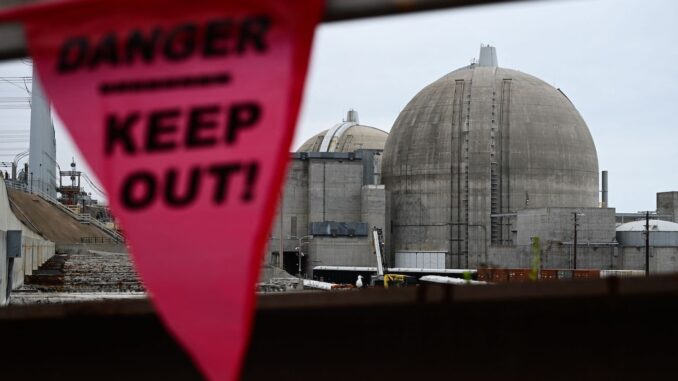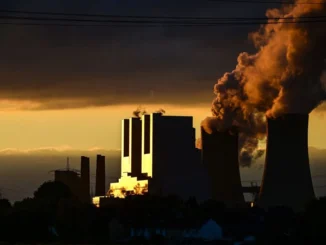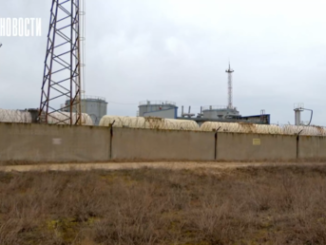
But Washington and its partners are working to change that.
Since Russia’s full-scale invasion of Ukraine over two years ago, the West has already made serious strides to wean itself off reliance on Russian energy exports such as oil and natural gas. But deepening dependence on another Russian energy export is causing alarm in Washington, London, and Paris: Moscow’s dominance of the global trade in enriched uranium used to fuel nuclear reactors.
While Russia has lost its dominant position in oil and gas exports since the war in Ukraine began more than two years ago, it continues to be the biggest player globally in providing nuclear fuel, accounting for over 40 percent of the global market, including to Europe and especially to the United States, the biggest single buyer of enriched Russian uranium.
What’s more, Russia has a complete monopoly on the production of advanced nuclear fuel that will be needed to power the next generation of nuclear reactors, upon which so many hopes rest in the West for fighting climate change. Russia hasn’t yet used its exports of uranium as a geopolitical weapon, unlike its exports of natural gas—but it could at almost any time.
That’s why the United States, the United Kingdom, France, and important Western nuclear fuel providers have in recent months announced plans to expand their own capacity to enrich uranium, while broaching the idea of a complete ban on Russian imports in years to come.
Uranium ore, the raw material for nuclear power, is mined around the world, including by a number of close U.S. allies. But the enrichment process, which turns it into fuel for use in reactors, is dominated by just four companies—Russia’s Rosatom, China’s CNNC, the Western consortium Urenco, and the French Orano. Given the role of uranium enrichment in the development of nuclear weapons, it is a choke point by design. “This is a technology we’ve tried to keep contained,” said Matt Crozat, executive director for strategy and policy development at the Nuclear Energy Institute.
The United States last month announced a $2.7 billion plan to boost domestic production of uranium fuel, while France last year announced a big increase in its own ability to turn raw uranium into usable nuclear fuel. Urenco, the big Western consortium grouping fuel producers in the U.K., the Netherlands, Germany, and the United States, is racing to expand output capacity in all its member countries. The United States and the U.K. have also announced ambitious plans to start producing commercial quantities of the advanced uranium that will be the mainstay fuel of the future.
The West has levied sanctions on Russian oil and gas exports—but not on uranium. “The nuclear sector is very tricky,” said David O’Sullivan, the EU’s top sanctions envoy, during a visit to Washington last month. “I think this is one area where we can all agree it would be nice to be able to move forward on sanctions. Unfortunately, the level of dependence at this point is such that it is difficult,” he said.
With so many countries planning a rapid increase in nuclear power, the world will need a big increase in the capacity to make the fuel to run the plants, said Lindsey Walter, the director of international policy for climate and energy at Third Way, a think tank that has studied this issue. And, as with so many critical materials from rare earth metals to semiconductors, the impetus is toward re-shoring and away from reliance on decades-old globalized trade patterns, especially when the go-to providers are mischief-makers.
“Currently, Russia and China dominate the market, and Russia has proven its desire to weaponize energy for geopolitical gain,” Walter said. Together with the huge expansion planned for civil nuclear power, “it’s a combination that is driving this push.”
The United States relies on Russia for about one-quarter of the enriched uranium to power its 93 nuclear reactors. It’s a relationship that was cemented by the Megatons to Megawatts program created after the fall of the Soviet Union in which decommissioned nuclear weapons were reconstituted to provide fuel for U.S. reactors and strengthen diplomatic ties between the erstwhile Cold War rivals. “It was thought to be a very strategically valuable way to ensure that these capabilities weren’t being used for nefarious purposes,” Crozat said.
But in the wake of Russia’s invasion of Ukraine and ongoing Western efforts to decouple from reliance on Russia for any key materials, calls are growing louder on Capitol Hill to sever that decades-old dependence. The House of Representatives passed legislation last year that would ban imports of Russian uranium by 2028, a call echoed by the U.S. energy secretary, though it has not yet been taken up by the Senate.
“One of the most urgent security threats America faces right now is our dangerous reliance on Russia’s supply of nuclear fuels for our nuclear fleet,” said Rep. Cathy McMorris Rodgers, the chair of the House Energy Committee, discussing the bill ahead of its passage. “We’ve seen how [Russian President Vladimir] Putin has weaponized Europe’s reliance on Russian natural gas. There’s no reason to believe Russia wouldn’t do the same with our nuclear fuel supply, if Putin saw an opportunity.”
Unlike with natural gas, though, Moscow has not so far tried to use its dominant position in uranium supply as a cudgel. Rosatom, Russia’s state-owned nuclear behemoth, continues to supply utilities in the United States and across Europe and in other countries under long-term contracts, even increasing its export revenue during the war. Rosatom, even more than its gas-producing counterpart Gazprom, is keen to preserve its reputation as a reliable supplier, said Dmitry Gorchakov, a nuclear advisor at Bellona, a Norway-based environmental nonprofit.
Rosatom has played a leading role in Russia’s nuclear energy diplomacy around the world, acting as a one-stop shop for construction, fuel, and waste disposal. Russia was named as the supplier in half of all international agreements to build and sustain nuclear power plants between 2000 and 2015, according to a study published in Nature Energy, providing Moscow with other avenues of influence.
But Putin could still order the firm to curtail supplies, which would cause a serious short-term supply crunch for utilities in Europe and the United States, Gorchakov said, as well as raise already-high prices for enriched uranium. Such a move could be even more palatable for the Kremlin than the weaponization of gas exports because of the relatively small dollar amounts involved: Rosatom only makes about $3 billion a year from uranium fuel sales abroad, versus the $200-odd billion it made in oil and gas sales before the war wrecked its main export market.
One sign that nuclear operators everywhere are getting nervous about a sudden Russian fuel embargo was the huge uptick in imports of Russian fuel by Eastern European countries last year. Those countries all run Soviet-era reactors that require special fuel assemblies usually made by Rosatom and its subsidiaries.
“Now we see it as a trend—almost all those countries are buying much more fuel. Our hypothesis is that they are trying to make stockpiles” against a possible Russian supply cut, Gorchakov said. While Westinghouse, the U.S. nuclear company, has made great strides in providing some fuel assemblies for Soviet-era reactors, notably in Ukraine, it is still working to be able to reliably fuel the majority of the older-generation reactors that run power grids in countries such as the Czech Republic, Hungary, Slovakia, and Finland.
The big question is whether the United States and other Western countries can increase their production of enriched uranium, even the old-school variety used in present-day reactors, quickly enough to provide supply assurances against any Russian interruption.
The United States’ multibillion-dollar injection into the domestic enrichment industry will only even be activated if Congress formally bans the import of Russian uranium, a step that has yet to advance despite bipartisan support. “We need the ban before we can unlock the money” for new U.S. enrichment, Walters said.
While Urenco and Orano, the French nuclear fuel provider, have expansion plans in place, they won’t be operational until later this decade. “The West still needs to do more. We need to look at real steps, not words,” Gorchakov said. “If Urenco and Orano manage a real increase in capacity, then it will work. If they don’t, the U.S. alone cannot produce enough” in the medium term, he said.
In the longer term, the next challenge will be to end Russia’s current monopoly on the production of so-called high-assay low-enriched uranium, or HALEU, a nuclear fuel enriched to much higher levels than the variety widely used in existing reactors. That is what will power the smaller reactors of the future if and when they are built. “The Western nuclear future is dependent on HALEU,” Gorchakov said. “That is not a today problem; it is a future problem.”
For now, there might be one more problem with the Western, and especially U.S., effort to kick the habit of Russian nuclear fuel. In the last two years, Russia has increased its exports of enriched uranium to China, which itself is a sizable producer of enriched uranium. At the same time, last year, China for the first time became a significant exporter of enriched uranium to the United States.
Experts say that without access to confidential fuel supply contracts, it is hard to conclude that direct displacement of Russian uranium in the United States by Chinese equivalents is taking place, but they caution that trading dependence on Russia for greater reliance on China would hardly solve the problem.
“Chinese imports from Russia have increased, with high volumes historically speaking, and now there is a frankly quite impressive increase of exports from China to the U.S.,” said Darya Dolzikova of the Royal United Services Institute. “You can’t rule out displacement.”



